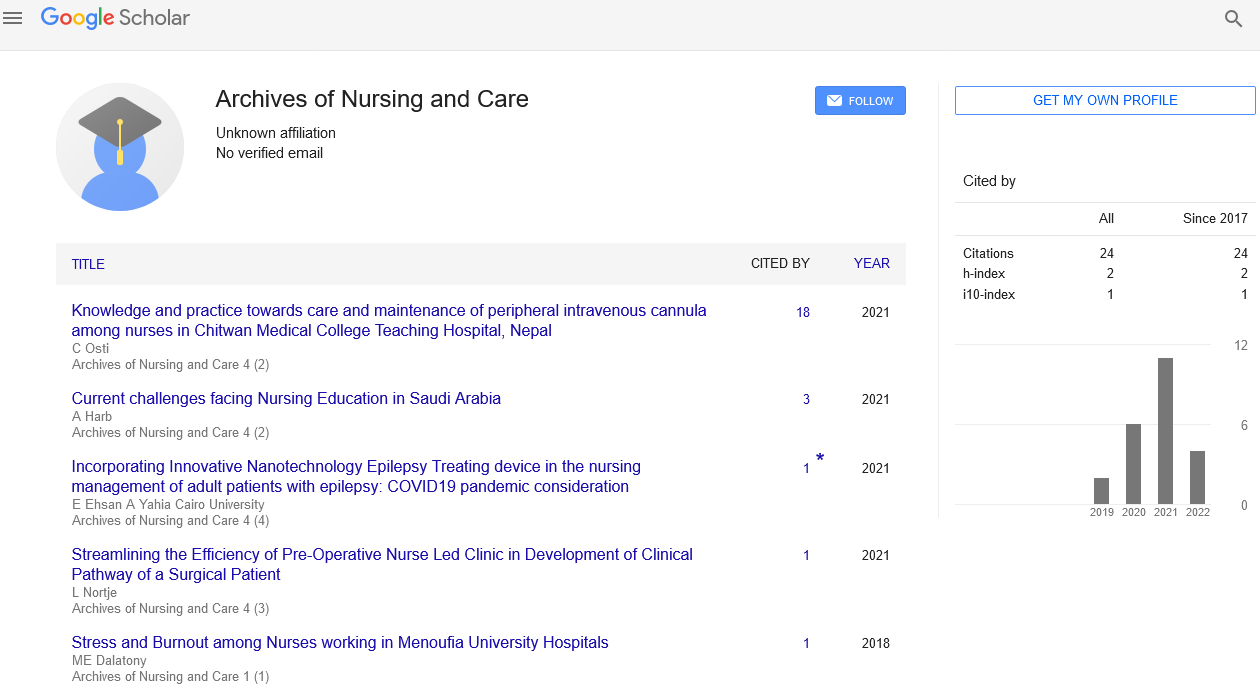Review Article - Archives of Nursing and Care (2023) Volume 6, Issue 1
Mental Health Nursing
Kayla Nixon*
Victorian Institute of Forensic Mental Health (Forensicare), Australia
Victorian Institute of Forensic Mental Health (Forensicare), Australia
E-mail: nixonkayla@rediff.com
Received: 02-Jan-2023, Manuscript No. OANC-23-86217; Editor assigned: 04-Jan-2023, PreQC No. OANC-23-86217 (PQ); Reviewed: 18-Jan-2023, QC No. OANC-23- 86217; Revised: 23-Jan-2023, Manuscript No. OANC-23-86217 (R); Published: 30-Jan-2023; DOI: 10.37532/oanc.2023.6(1).004-006
Abstract
The treatment of people with mental illness through institutionalisation and into contemporary psychiatric nursing practises has been influenced by the discourse on safety. Confinement developed out of concerns for public safety, societal stigma, and benevolently paternalistic efforts to keep people from harming themselves. In this essay, we contend that risk management serves as the cornerstone of nursing care in current mental inpatient contexts, where safety is maintained as the primary value. Despite evidence disputing their efficacy and patient opinions revealing harm, practises that uphold this ideal are justified and maintained through the safety discourse. We offer four examples of risk management techniques used in psychiatric inpatient settings—close observations, isolation, door locking, and defensive nursing practice—to show this developing issue in mental health nursing care. The implementation of these techniques illustrates the need to change nursing care's viewpoints on safety and risk. We propose that nurses should provide tailored, flexible care that takes safety precautions into account in order to recenter meaningful support and treatment of clients. They should also fundamentally reevaluate the risk management culture that fosters and justifies dangerous practises [1].
Keywords
mental health • nursing practice • patient safety • risk management
Introduction
The idea of safety elicits a group of ideas throughout health care environments, including patient safety, quality assurance, and quality improvement. Protecting patients from harms resulting from adverse events in care, such as medication errors, poor handover communication, insufficient staffing, or inadequate training on new technologies, is the definition of safety in nursing practise (Sherwood, 2015). The notion of patient risk, which refers to the harms that a patient creates within the environment, such as violence, aggression, self-harm, or suicide, is frequently used in place of discussions of patient safety issues resulting from harms of the health care environment in the field of mental health care, according to Kannerva, Lammintakanen, and Kivinen (2016). Compared to other hospital settings, in psychiatric inpatient settings, the concept of patient risk is broadened to include not just the individual but also other patients, staff, and the general public. Risk, according to Lupton (2013), is the potential for unfavourable or dangerous outcomes paired with the conviction that these events may be avoided [2]. This essay uses Lupton's concept to make the case that the primary goal of psychiatric nursing is to maintain safety through methods that recognise potential dangers and take preventative action. By adopting a custodial position in their nursing practise, nurses uphold patient safety, which includes risk management techniques like seclusion (isolating a person in a designated locked room) or forced medication to maintain safety through containment of a person's behaviour or person. Locked unit doors, enclosed nursing stations, and open "fishbowl" settings are just a few of the environmental risk management techniques used to achieve this similar goal. Although some dissenting voices in the field of mental health contend that psychological safety, freedom from anxiety and disempowering experiences, is an important factor in conceptualising safety in mental health inpatient environments, the discourse of safety focuses almost exclusively on identifying and controlling the risks that patients pose while they are in the hospital [3].
Safety is the highest value in inpatient nursing care in this setting, not just a factor or goal. The first goal of psychiatry, according to Bowers, Banda, and Nijman (2010), is to keep patients and other people safe. Safety is the top priority for mental health researchers and nurses working in psychiatric professions, and they use this value to guide their clinical judgement, nursing interventions, and practises [4]. The safety discourse initially seems to be in line with ethical nursing practise, where risk management implies a moral obligation to safeguard the patient population, healthcare professionals, and the general public through beneficence, harm minimization, and wellness promotion. The prevalence of this discourse, however, obscures the fact that many nursing practises intended to maintain safety are physically and/or psychologically harmful, undermining the compatibility of risk management strategies with ethical practise. According to Landeweer (2011), the framework of safety in nursing care gives the impression that risk management techniques like seclusion are only used when absolutely essential [5]. According to this belief, selfreflection and ethical reflection have no role in nursing care, which automatically justifies nursing methods. Safety is a well-intentioned and significant value at the individual, institutional, and system levels; nevertheless, in a setting where patients are routinely kept for unwarranted care and deemed unable to control risk, safety has the potential to act as a free pass for nursing practise [6].
In this essay, we contend that the rhetoric of safety—defined as risk identification and related risk management techniques (Lupton, 2013)—gives birth to and legitimises nursing practises that are ineffectual and unethical and supplant meaningful therapy in psychiatric inpatient settings. We set the prevailing safety viewpoints in the context of institutionalisation history. Then, we provide four examples to show how the discourse of safety is applied to guide practises in risk management. We conclude with suggestions for rethinking safety and risk in relation to nursing practise and inpatient psychiatric care [7].
Safety in an Institutionalized Era
It is useful to think about the historical dynamics from which it evolved, particularly the development of nursing risk management methods, in order to comprehend how the safety discourse came to be seen as a central value in mental health nursing. The writings Asylums by Goffman (1961) and Madness and Civilization by Foucault (1965) are offered in this section as examples of texts that offer a historical backdrop for the development of institutions intended to contain and keep apart people with mental illness from the rest of society. Each of these authors provides theoretical insights that shed light on how techniques used to reduce risk and maintain safety are justified, adding to our understanding of risk management culture in psychiatric nursing practice [8].
According to Goffman (1961), the creation of intricate and oppressive interior environments that permeate a person's entire life causes society's complete institutions—a group that includes prisons, labour camps, and mental hospitals—to break a person's connection to the outside world. With admittance to a total institution, convicts experience a mortification in which autonomy and self-expression are substituted with behaviours that are institutionally managed. The environment is one of surveillance and control. In the mental institution, for instance, inmates are constantly watched and supervised, and they are given a small window of permissible behaviour and expression that is not seen as a sign of mental illness. People who act in a disruptive or disorderly manner risk punishments including losing the right to wear off-ground or private apparel, being isolated in rooms and being physically restrained, or even suffering bodily injury like famine and labour [9]. Any staff member in the "asylum" has the authority to use force and control over any inmate, creating a setting in which there are constant and widespread constraints on personal freedom and mortifications are institutionally condoned.
Changing the Safety Conversation
These four examples show how the safety discourse works to support and justify nurses' employment of inadequate risk-identification and risk-reduction techniques in mental health clinical settings. Safety continues to be the major goal of inpatient treatment despite harms suffered by patients who were purportedly protected by these interventions, such as traumatic and degrading experiences and the maintenance of restrictive and controlled surroundings. The writings of Goffman and Foucault illustrate the historical context in which safety within psychiatric institutions has legitimised and sustained harmful practises; in contemporary nursing care, risk management strategies continue to produce harms despite deinstitutionalization initiatives and the development of ethical standards for nursing practise. While patient safety must always be a priority in mental health nursing, fully empowering patients is as crucial inside the hospital context entails ending intrusive and damaging activities that have been justified by the safety discourse as it has been expressed and operationalized in present nursing practise. The definition of safety itself must be changed, and other care methods and frameworks must be given precedence, in order to alter how risk is conceptualised and managed in psychiatric inpatient care. We propose re-evaluating risk and shifting responsibility as two methods for changing the safety discourse in mental health nursing [10].
Conclusions
The safety discourse frames the nature of care delivery for nurses working in mental health inpatient care settings, guiding identification of risks posed by the patients under their care and the treatments used to manage these risks. The primary goal of inpatient psychiatric care is safety, yet this ostensibly good objective is actually entrenched in stigma, fear, and a history of institutionalisation. The articulation and operationalization of the safety value justifies the continued use of nursing techniques that are ineffective and harmful to both patients and nurses in inpatient settings. While safety is an essential part of inpatient mental health nursing care, its use and framing must change to produce conditions that are regarded as truly safe and to promote meaningful participation in and treatment from therapy meaningful participation in and treatment from therapy.
References
- Happell B, Gaskin CJ. The attitudes of undergraduate nursing students towards mental health nursing: A systematic review. Journal of clinical nursing. 22, 148-158 (2013).
- Edwards D, Burnard P, Coyle D, et al. Stress and burnout in community mental health nursing: a review of the literature. Journal of psychiatric and mental health nursing. 7, 7-14 (2000).
- Ward L. Mental health nursing and stress: Maintaining balance. International journal of mental health nursing. 20, 77-85 (2011).
- Brown AM. Simulation in undergraduate mental health nursing education: A literature review. Clinical Simulation in Nursing. 11, 445-449 (2015).
- Barker P, Buchanan‐Barker P. Myth of mental health nursing and the challenge of recovery. International Journal of Mental Health Nursing. 20, 337-344 (2011).
- Liben S, Papadatou D, Wolfe J. Paediatric palliative care: challenges and emerging ideas. The Lancet. 371, 852-864 (2008).
- Williams‐Reade J, Lamson AL, Knight SM, et al. Paediatric palliative care: a review of needs, obstacles and the future. Journal of Nursing Management. 23, 4-14 (2015).
- Hill K, Coyne I. Palliative care nursing for children in the UK and Ireland. British journal of nursing. 21, 276-281 (2012).
- Couch E, Mead JM, Walsh MM. Oral health perceptions of paediatric palliative care nursing staff. International journal of palliative nursing. 19, 9-15 (2013).
- Harrop E, Edwards C. How and when to refer a child for specialist paediatric palliative care. Archives of Disease in Childhood-Education and Practice. 98, 202-208 (2013).
Indexed at, Google Scholar, Crossref
Indexed at, Google Scholar, Crossref
Indexed at, Google Scholar, Crossref
Indexed at, Google Scholar, Crossref
Indexed at, Google Scholar, Crossref
Indexed at, Google Scholar, Crossref
Indexed at, Google Scholar, Crossref
Indexed at, Google Scholar, Crossref
Indexed at, Google Scholar, Crossref

